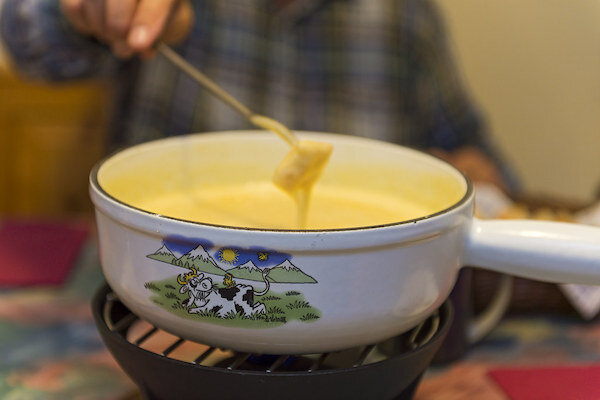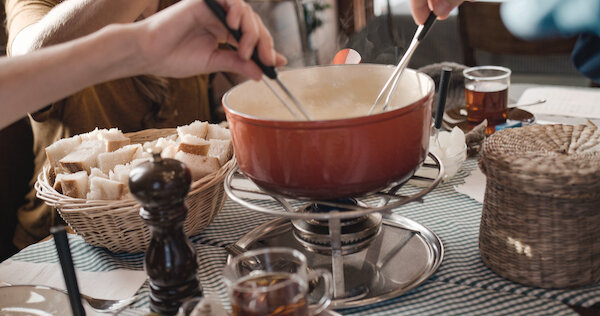The Rituals of the Fondue Party
“Fondue, in the end is a simple dish, and so a whole host of rituals and terms have grown up around it, to give some sense of the exotic to it, to make it all feel festive.” So says Isabelle Raboud-Schüle, the director of the Gruyere Museum, an institution in the town that gave the cheese its name. She's one of the world's leading experts in the history of fondue. When, over Zoom, I ask the trained ethnologist why the crusty bit of cheese you sometimes get at the bottom of the fondue pot is called la réligieuse, French for nun, she won't speculate. “You know fondue's a social dish, and so each person who serves you it will have their own theories, and you can all discuss those, while the cheese bubbles away.”
"FIGUGEGL Fondue Dinner" by Daniel Gasienica is licensed under CC BY-NC-ND 2.0
Terms of Endearment: This term for the crusty bit at the bottom of the pot is one of many to have grown up around fondue. From the ubiquitous ad campaigns mainly funded by the Swiss Cheese union to promote the dish comes a tongue-twisting word, Figugegl. The word has made its way onto T-shirts, and is an acronym from the Swiss-German phrase, “Fondue isch guet und git e gueti Luune" – literally, fondue is good and creates a good mood. The pots – formerly all ceramic before the rise of electric and gas stoves – have held onto an old French term for cookware, caquelon.
Crime and Punishment: At a restaurant near Zermatt, the waiter once told me and a group of friends that it was customary for any two people who lost their bread in the sauce to kiss each other – sort of an Alpine version of Spin-the-Bottle. A raucous evening of strategically discarded, pulled off and retained bread cubes resulted. Turns out this is one of many jokey punishments meted out in Switzerland and the French Alps for the high crime of losing one's bread. Sometimes the person who does so has to take care of the dishes, to sing a song or to pay for the next bottle of wine; sometimes, if the setting permits, naked rolls in the snow or skinny dips in nearby waters are required. The tradition comes in for a bit of gentle mocking in one installment of the long-running French comic series Astérix set in an ancient version of Switzerland. There, the indomitable Gauls featured in the series come upon a fondue party where guests who drop their bread in the pot may be beaten, whipped or dumped in Lake Geneva.
Drinks: The classic accompaniments to fondue are black tea and the acidic wines grown in the region, especially those from French Savoy. The Executive Chef of the Swiss Consulate in New York, Yannick Germanier grew up near Lausanne, and says it's also normal, halfway through consuming a fondue, to have a shot of kirsch, the liqueur used in many recipes to finish the dish – the term for this customary hit, he says, is the coup du milieu.
Dippers: With the fondues he's prepared at the consulate, Germanier tends to serve bread, cooked potatoes, and pickled vegetables, including onions, cornichons and wild mushrooms. “The acid in the vinegar cuts the fat in the cheese some,” he says. During our prolonged shelter-in-place in Oakland, we experimented with many dippers going from the traditional cubed bread and cooked potatoes, to baked fennel, sweated mushrooms, assorted charcuterie and sliced apple (all excellent), to cooked broccoli, zucchini and asparagus (meh) to tomatoes, dried figs and cherries (highly, highly not recommended).
Sex and Fondue: The hot, sticky, gooey dish seems to have become associated, in the popular mind, with sex. His Flirty Fondue is one of several romance novels featuring it – in it, boy meets girl at a fondue festival. And the term “fonduing” is gay argot for hooking up with someone out of your league.
Photo by Dan DeAlmeida on Unsplash
Stirring: Caroline Hostettler, an importer of the cheeses of her native Switzerland to America and a self-identified fondue purist, says only a wooden spoon will do for stirring the dish. “Once the cheese goes into the wine, you do it constantly until it hits the table – and, this is maybe a little silly, but the tradition is you move the spoon in a figure-eight pattern, or in the shape of the Swiss cross.”
'Tis not the Season: Just as the Italians discourage the drinking of cappuccinos after noon, the Swiss don't approve of people eating fondue in warm weather. “The tourists do it when they visit,” Germanier says. “But the locals don't eat it in the summer.”
Finishing Touches: Towards the end of preparing fondues at the consulate, Germanier tends to dash in some baking soda. “Makes it fluffier, less heavy.”
If the dish gets a crust of cheese at the bottom, the so-called la réligieuse, it's not unusual, Raboud-Schüle says, for hosts to crack an egg over it, and serve that up as a fondue party's finale.




